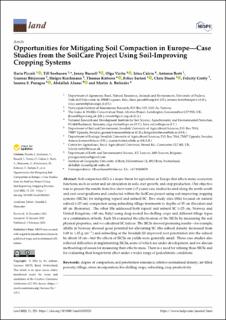| dc.contributor.author | Piccoli, Ilaria | |
| dc.contributor.author | Seehusen, Till | |
| dc.contributor.author | Bussell, Jenny | |
| dc.contributor.author | Vizitu, Olga | |
| dc.contributor.author | Calciu, Irina | |
| dc.contributor.author | Berti, Antonio | |
| dc.contributor.author | Börjesson, Gunnar | |
| dc.contributor.author | Kirchmann, Holger | |
| dc.contributor.author | Kätterer, Thomas | |
| dc.contributor.author | Sartori, Felice | |
| dc.contributor.author | Stoate, Chris | |
| dc.contributor.author | Crotty, Felicity | |
| dc.contributor.author | Panagea, Ioanna S. | |
| dc.contributor.author | Alaoui, Abdallah | |
| dc.contributor.author | Bolinder, Martin A. | |
| dc.date.accessioned | 2022-07-20T11:28:36Z | |
| dc.date.available | 2022-07-20T11:28:36Z | |
| dc.date.created | 2022-03-28T18:01:31Z | |
| dc.date.issued | 2022-02-02 | |
| dc.identifier.citation | Land. 2022, 11 (2), 1-26. | en_US |
| dc.identifier.issn | 2073-445X | |
| dc.identifier.uri | https://hdl.handle.net/11250/3007222 | |
| dc.description.abstract | Soil compaction (SC) is a major threat for agriculture in Europe that affects many ecosystem functions, such as water and air circulation in soils, root growth, and crop production. Our objective was to present the results from five short-term (<5 years) case studies located along the north–south and east–west gradients and conducted within the SoilCare project using soil-improving cropping systems (SICSs) for mitigating topsoil and subsoil SC. Two study sites (SSs) focused on natural subsoil (˃25 cm) compaction using subsoiling tillage treatments to depths of 35 cm (Sweden) and 60 cm (Romania). The other SSs addressed both topsoil and subsoil SC (˃25 cm, Norway and United Kingdom; ˃30 cm, Italy) using deep-rooted bio-drilling crops and different tillage types or a combination of both. Each SS evaluated the effectiveness of the SICSs by measuring the soil physical properties, and we calculated SC indices. The SICSs showed promising results—for example, alfalfa in Norway showed good potential for alleviating SC (the subsoil density decreased from 1.69 to 1.45 g cm−1) and subsoiling at the Swedish SS improved root penetration into the subsoil by about 10 cm—but the effects of SICSs on yields were generally small. These case studies also reflected difficulties in implementing SICSs, some of which are under development, and we discuss methodological issues for measuring their effectiveness. There is a need for refining these SICSs and for evaluating their longer-term effect under a wider range of pedoclimatic conditions. | en_US |
| dc.language.iso | eng | en_US |
| dc.publisher | MDPI, Basel, Switzerland | en_US |
| dc.rights | Navngivelse 4.0 Internasjonal | * |
| dc.rights.uri | http://creativecommons.org/licenses/by/4.0/deed.no | * |
| dc.title | Opportunities for mitigating soil compaction in Europe—Case studies from the SoilCare project using soil-improving cropping systems | en_US |
| dc.title.alternative | Opportunities for mitigating soil compaction in Europe—Case studies from the SoilCare project using soil-improving cropping systems | en_US |
| dc.type | Peer reviewed | en_US |
| dc.type | Journal article | en_US |
| dc.description.version | publishedVersion | en_US |
| dc.rights.holder | © 2022 by the authors | en_US |
| dc.source.pagenumber | 26 | en_US |
| dc.source.volume | 11 | en_US |
| dc.source.journal | Land | en_US |
| dc.source.issue | 2 | en_US |
| dc.identifier.doi | 10.3390/land11020223 | |
| dc.identifier.cristin | 2013124 | |
| dc.relation.project | EC/H2020/677407 | en_US |
| dc.source.articlenumber | 223 | en_US |
| cristin.ispublished | true | |
| cristin.fulltext | original | |
| cristin.qualitycode | 1 | |

